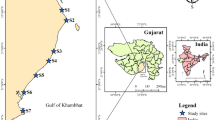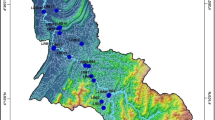Abstract
The study was designed to collect water samples over two seasons—wet-monsoon season (n = 96) (March–April) and dry-monsoon season (n = 44) (September–October)—to understand the seasonal variation in anion and cation hydrochemistry of the coastal rivers and estuaries contributing in the spatial trend in salinity. Hydrochemical examination of wet-monsoon season primarily revealed Ca–Mg–HCO3 type (66%) and followed by Na–Cl type (17.70%) water. In the dry-monsoon season, the scenario reversed with primary water being Na–Cl type (52.27%) followed by Ca–Mg–HCO3 type (31.81%). Analysis of Cl/Br molar ratio vs. Cl (mg/L) depicted sampling area affected by seawater intrusion (SWI). Spatial analysis by ordinary kriging method confirmed approximately 77% sample in the dry-monsoon, and 34% of the wet-monsoon season had shown SWI. The most saline-intruded areas in the wet-monsoon seasons were extreme south-west coastal zone of Bangladesh, lower Meghna River floodplain and Meghna estuarine floodplain and south-eastern part of Chittagong coastal plains containing the districts of Chittagong and Cox’s Bazar adjacent to Bay of Bengal. In addition, mid-south zone is also affected slightly in the dry-monsoon season. From the analyses of data, this study could further help to comprehend seasonal trends in the hydrochemistry and water quality of the coastal and estuarine rivers. In addition, it can help policy makers to obligate some important implications for the future initiatives taken for the management of land, water, fishery, agriculture and environment of coastal rivers and estuaries of Bangladesh.







Similar content being viewed by others
References
Afroz T, Alam S (2013) Sustainable shrimp farming in Bangladesh: a quest for an integrated coastal zone management. Ocean Coast Manage 71:275–283
Ahmed AU, Alam M (1999) Development of climate change scenarios with general circulation models. In: Huq S, Karim Z, Asaduzzaman M, Mahtab F (eds) Vulnerability and adaptation to climate change for Bangladesh. Kluwer Academic Publishers, Dordrecht, pp 13–20
American Public Health Association (APHA) (2005) Standard methods for the examination of water and wastewater. American Public Health Association, Washington, DC
Aziz JJ, Ling M, Rifai HS, Newell CJ, Gonzales JR (2003) MAROS: a decision support system for optimizing monitoring plans. Ground Water 41(3):355–367
Bahar MM, Reza MS (2010) Hydrochemical characteristics and quality assessment of shallow groundwater in a coastal area of Southwest Bangladesh. Environ Earth Sci 61(5):1065–1073
Bear J, Cheng AHD, Sorek S, Ouazar D, and Herrera I (eds) (1999) Seawater intrusion in coastal aquifers: concepts, methods and practices (Vol. 14). Springer Science & Business Media
Bhuiyan MJAN, Dutta D (2012) Assessing impacts of sea level rise on river salinity in the Gorai river network, Bangladesh. Estuar Coast Shelf Sci 96:219–227
Brammer H (2004) Can Bangladesh be protected from floods? University Press Ltd, Dhaka
Brammer H (2014a) Climate change, sea-level rise and development in Bangladesh. University Press Ltd, Dhaka
Brammer H (2014b) Bangladesh’s dynamic coastal regions and sea-level rise. Climate Risk Manage 1:51–62
Canedo-Arguelles M, Kefford BJ, Piscart C, Prat N, Schafer RB, Schulz CJ (2013) Salinisation of rivers: an urgent ecological issue. Environ Pollut 173:157–167
Da Lio C, Carol E, Kruse E, Teatini P, Tosi L (2015) Saltwater contamination in the managed low-lying farmland of the Venice coast, Italy: an assessment of vulnerability. Sci Total Environ 533:356–369
DoE/MOEF/GOB (2006) Bangladesh, national programme of action for protection of the coastal and marine environment from land-based activities. Department of Environment, Ministry of Environment and Forests, Government of the People's Republic of Bangladesh, Dhaka
FAO (1985) FAO report on tidal area study. Fisheries resources survey system. FAO/UNDP-BGD/79/015.http://www.fao.org/docrep/field/003/ac352e/AC352E00.htmTOC. Accessed on 15th March 2016
FAO (2017) Applying flexible cropping schedules for rice (t. aman) production in Bangladesh. http://teca.fao.org/read/6853. Accessed 30th January 2017
Gain A, Giupponi C (2014) Impact of the Farakka Dam on thresholds of the hydrologic flow regime in the lower Ganges River basin (Bangladesh). Water 6(8):2501–2518
Ghabayen SMS, McKee M, Kemblowski M (2006) Ionic and isotopic ratios for identification of salinity sources and missing data in the Gaza aquifer. J Hydrol 318(1–4):360–373
Ghosh P, Chakrabarti R, Bhattacharya SK (2013) Short- and long-term temporal variations in salinity and the oxygen, carbon and hydrogen isotopic compositions of the Hooghly Estuary water, India. Chem Geol 335:118–127
Halim MA, Majumder RK, Nessa SA, Hiroshiro Y, Sasaki K, Saha BB, Saepuloh A, Jinno K (2010) Evaluation of processes controlling the geochemical constituents in deep groundwater in Bangladesh: spatial variability on arsenic and boron enrichment. J Hazard Mater 180(1–3):50–62
Hotelling H (1933). Analysis of a complex of statistical variables into principal components. J Educ Psychol 24(6):417–441
Islam MA, Zahid A, Rahman MM, Rahman MS, Islam MJ, Akter Y, Shammi M, Bodrud-Doza M, Roy B (2016) Investigation of groundwater quality and its suitability for drinking and agricultural use in the south central part of the coastal region in Bangladesh. Expo Health. doi:10.1007/s12403-016-0220-z
Jiang Y, Guo H, Jia Y, Cao Y, Hu C (2015) Principal component analysis and hierarchical cluster analyses of arsenic groundwater geochemistry in the Hetao basin, Inner Mongolia. Chem Erde Geochem 75(2):197–205
Karanth KR (1994) Groundwater assessment development and management. Tata McGraw-Hill Publishing Company Limited, New Delhi (third reprint)
Katz BG, Eberts SM, Kauffman LJ (2011) Using Cl/Br ratios and other indicators to assess potential impacts on groundwater quality from septic systems: a review and examples from principal aquifers in the United States. J Hydrol 397(3–4):151–166
Kendall MG (1975) Rank correlation methods. Griffin, London
Khan A, Mojumder SK, Kovats S, Vineis P (2008) Saline contamination of drinking water in Bangladesh. Lancet 371(9610):385
Kisi O, Ay M (2014) Comparison of Mann–Kendall and innovative trend method for water quality parameters of the Kizilirmak River, Turkey. J Hydrol 513:362–375
Lee HS (2013) Estimation of extreme sea levels along the Bangladesh coast due to storm surge and sea level rise using EEMD and EVA. J Geophys Res: Oceans 118(9):4273–4285
Loitzenbauer E, Mendes CAB (2012) Salinity dynamics as a tool for water resources management in coastal zones: an application in the Tramandaí River basin, southern Brazil. Ocean Coast Manage 55:52–62
Mann HB (1945) Nonparametric tests against trend. Econometrica 13:245–259
Morell I, Gimhez E, Esteller M (1996) Application of principal components analysis to the study of salinization on the Castellon Plain (Spain). Sci Total Environ 177:161–171
MoWR (2005) Coastal Zone Policy (CZPo). Ministry of Water Resources (MoWR), New Delhi
Niazi F, Mofid H, Modares FN (2014) Trend analysis of temporal changes of discharge and water quality parameters of Ajichay River in four recent decades. Water Qual Exp Health 6(1–2):89–95
Otache M, Bakir M, Zhijia L (2008) Analysis of stochastic characteristics of the Benue River flow process. Chin J Oceanol Limn 26(2):142–151
Papa F, Bala SK, Pandey RK, Durand F, Gopalakrishna VV, Rahman A, Rossow WB (2012) Ganga-Brahmaputra river discharge from Jason-2 radar altimetry: an update to the long-term satellite-derived estimates of continental freshwater forcing flux into the Bay of Bengal. J Geophys Res: Oceans 117:C11021
Peck AJ, Hatton T (2003) Salinity and the discharge of salts from catchments in Australia. J Hydrol 272:191–202
Piper AM (1944) A graphic procedure in the geochemical interpretation of water analyses. Am Geoph Union Trans 25:914–923
Rahman AM, Rahman S (2015) Natural and traditional defense mechanisms to reduce climate risks in coastal zones of Bangladesh. Weather Climate Extremes 7:84–95
Salmi T, Maata A, Antilla P, Ruoho-Airola T, Amnell T (2002) Detecting trends of annual values of atmospheric pollutants by the Mann–Kendall test and Sen’s slope estimates—the Excel template application MAKESENS. Finnish Meteorological Institute, Helsinki
Samanta S, Dalai T (2016) Dissolved and particulate Barium in the Ganga (Hooghly) River estuary, India: solute-particle interactions and the enhanced dissolved flux to the oceans. Geochim Cosmochim Acta 195:1–28
Sarkar R, Vogt J (2015) Drinking water vulnerability in rural coastal areas of Bangladesh during and after natural extreme events. Int J Disaster Risk Reduct 14:411–423
Sen PK (1968) Estimates of the regression coefficient based on Kendall’s tau. J Am Stat Assoc 63:1379–1389
Shahid S (2010) Trends in extreme rainfall events of Bangladesh. Theor Appl Climatol 104(3–4):489–499
Shameem MIM, Momtaz S, Rauscher R (2014) Vulnerability of rural livelihoods to multiple stressors: a case study from the southwest coastal region of Bangladesh. Ocean Coast Manage 102:79–87
Shammi M, Bhuiya G, Ibne Kamal A, Rahman M, Rahman M, Uddin M (2012) Investigation of salinity occurrences in Kumar-Madhumati River of Gopalganj District, Bangladesh. J Nature Sci Sustainable Technol 6(4):299–313
Shammi M, Karmakar B, Rahman M, Islam M, Rahman R, Uddin M (2016) Assessment of salinity hazard of irrigation water quality in monsoon season of Batiaghata Upazila, Khulna District, Bangladesh and adaptation strategies. Pollution 2:183–197
Shelley I, Takahashi-Nosaka M, Kano-Nakata M, Haque M, Inukai Y (2016) Rice cultivation in Bangladesh: present scenario, problems, and prospects. J Intl Cooper Agric Dev 14:20–29
Siebert C, Möller P, Geyer S, Kraushaar S, Dulski P, Guttman J, Subah A, Rödiger T (2014) Thermal waters in the Lower Yarmouk Gorge and their relation to surrounding aquifers. Chem Erde Geochem 74(3):425–441
Spalding MD, Ruffo S, Lacambra C, Meliane I, Hale LZ, Shepard CC, Beck MW (2014) The role of ecosystems in coastal protection: adapting to climate change and coastal hazards. Ocean Coast Manage 90:50–57
Suen J-P, Lai H-N (2013) A salinity projection model for determining impacts of climate change on river ecosystems in Taiwan. J Hydrol 493:124–131
Takeuchi K, Xu ZX, Ishidiaira H (2003) Monitoring trend step changes in precipitation in Japanese precipitation. J Hydro 279:144–150
Thia-Eng C (1993) Essential elements of integrated coastal zone management. Ocean Coast Manage 21:81–108
Trabelsi N, Triki I, Hentati I, Zairi M (2016) Aquifer vulnerability and seawater intrusion risk using GALDIT, GQISWI and GIS: case of a coastal aquifer in Tunisia. Environ Earth Sci 75(8):1–19
Vengosh A, Ben-Zvi A (1994) Formation of a salt plume in the coastal plain aquifer of Israel: the Be’erToviyya region. J Hydrol 160:21–52
Vengosh A, Rosenthal E (1994) Saline groundwater in Israel: its bearing on the water crisis in the country. J Hydrol 156:389–430
Vengosh A, Spivack AJ, Artzi Y, Ayalon A (1999) Geochemical and boron, strontium, and oxygen isotopic constraints on the origin of the salinity in groundwater from the Mediterranean coast of Israel. Water Resour Res 35(6):1877–1894
Webster R, Oliver M (2001) Geostatistics for environmental scientists. Wiley, Chichester
Werner AD, Bakker M, Post VEA, Vandenbohede A, Lu C, Ataie-Ashtiani B, Simmons CT, Barry DA (2013) Seawater intrusion processes, investigation and management: recent advances and future challenges. Adv Water Resour 51:3–26
Williams WD (1987) Salinization of rivers and streams: an important environmental hazard. Ambio 16:181–185
Williams WD, Sherwood J (1994) Definition and measurement of salinity in salt lakes. Int J Salt Lake Res 3(1):53–63
Acknowledgements
This work has been supported by the project entitled “Establishment of monitoring network and mathematical model study to assess salinity intrusion in groundwater in the coastal area of Bangladesh due to climate change” implemented by Bangladesh Water Development Board and sponsored by Bangladesh Climate Change Trust Fund, Ministry of Environment and Forest.
Author information
Authors and Affiliations
Contributions
All authors discussed the results and implications and commented on the manuscript at all stages.
Corresponding author
Ethics declarations
Conflicts of interest
The authors declare that they have no conflict of interests.
Additional information
Responsible editor: Philippe Garrigues
Rights and permissions
About this article
Cite this article
Shammi, M., Rahman, M.M., Islam, M.A. et al. Spatio-temporal assessment and trend analysis of surface water salinity in the coastal region of Bangladesh. Environ Sci Pollut Res 24, 14273–14290 (2017). https://doi.org/10.1007/s11356-017-8976-7
Received:
Accepted:
Published:
Issue Date:
DOI: https://doi.org/10.1007/s11356-017-8976-7




